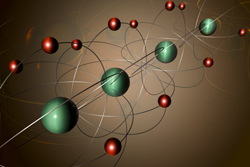Online simulations of radioactive ion beams
The current chart of nuclei includes around 3000 nuclides, distributed as stable and spontaneously splitting isotopes. An equal number of exotic nuclei belong to the so-called 'terra incognita', the vast unknown region of the nuclear chart where many unexpected structures have recently been discovered. Exotic nuclei synthesised in the laboratory allow for the variations within the tightly bound nuclear systems of proton and neutrons that are needed to uncover the true nature of the subatomic structures. The exploration of these unstable nuclei that cannot survive on Earth has been significantly assisted by the use of radioactive ion beams. With the Isotope separator on line (ISOL) method very intense beams of trillions of radioactive ions per second are obtained. Once they are released from the target which is heated to several thousand degrees, radioactive atoms are ionised and purified before being sent to individual experimental facilities. The release efficiency depends on the diffusion of nuclides in the target, effusion to the ioniser cavity and absorption/desorption processes at each surface collision, to name a few factors. Simulations of all these processes allow the study and subsequently, optimisation of the geometry and composition of the target and ion source system. The Isotope release simulator (IRES) is an online configuration tool, developed by the TARGISOL project to allow scientists to follow the path of nuclides from the target to the ion source. A web interface provides remote access to a Monte Carlo program, the Radioactive Ion Beam Optimizer (RIBO) that simulates targets made of powders or fibres with variable geometries stored in a database. The database also includes diffusion parameters and absorption enthalpies to be selected for the specific choice of target material. RIBO runs online from a server at http://www.targisol.csic.es/intro_ires.html(opens in new window). The results of simulations are sent to the user by e-mail.







